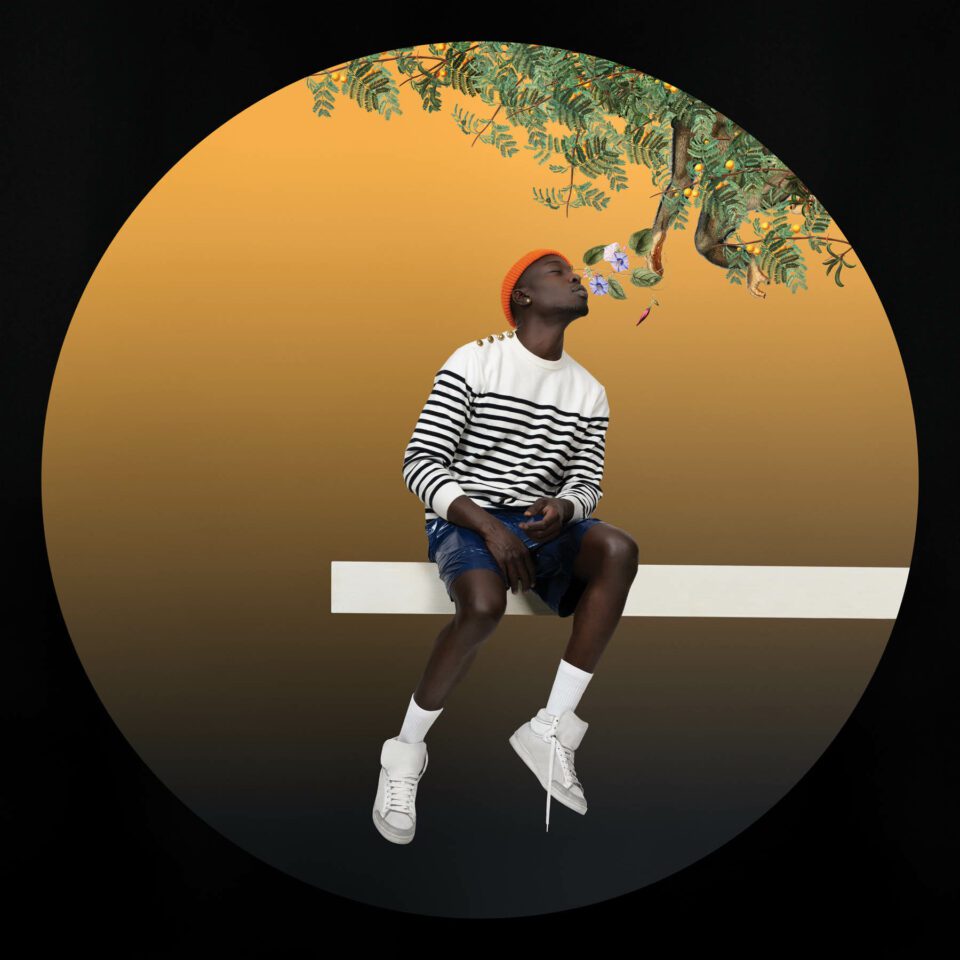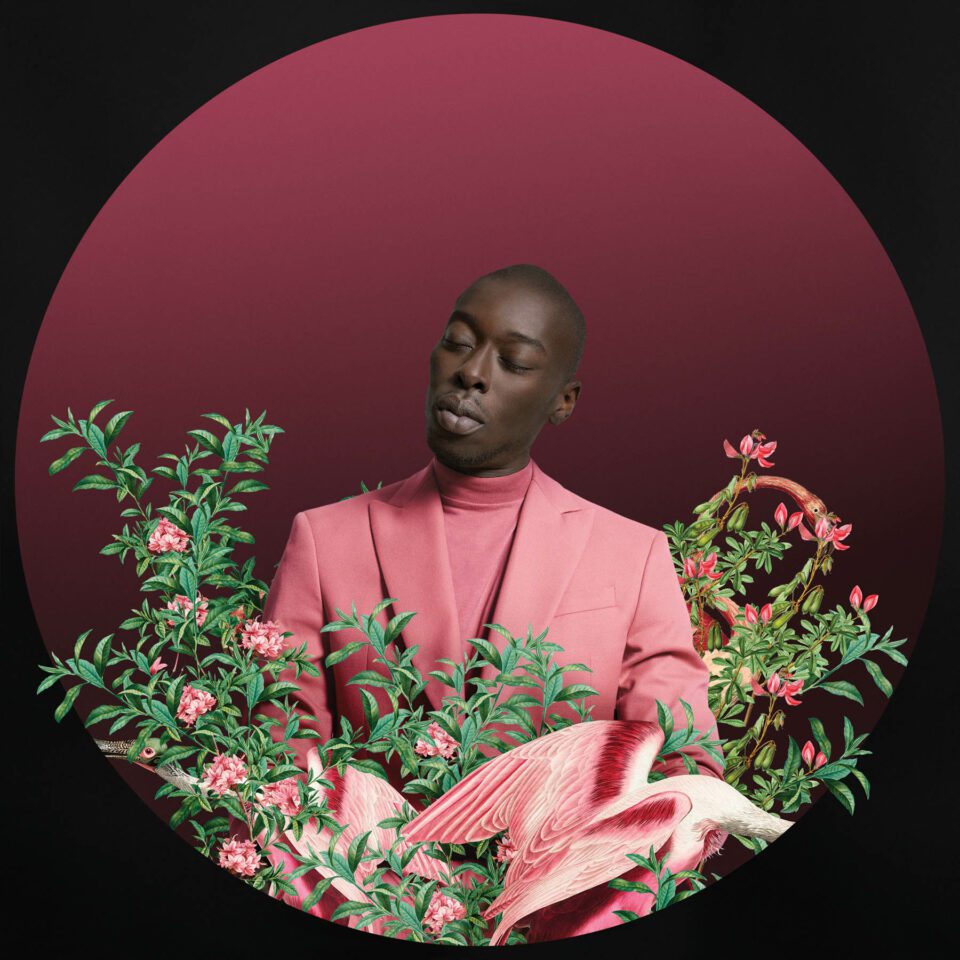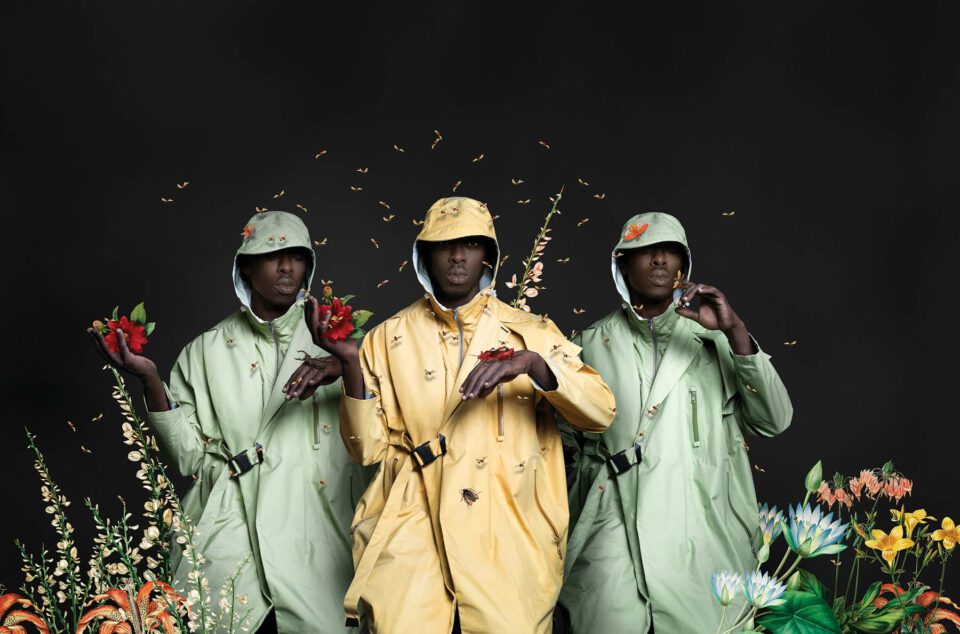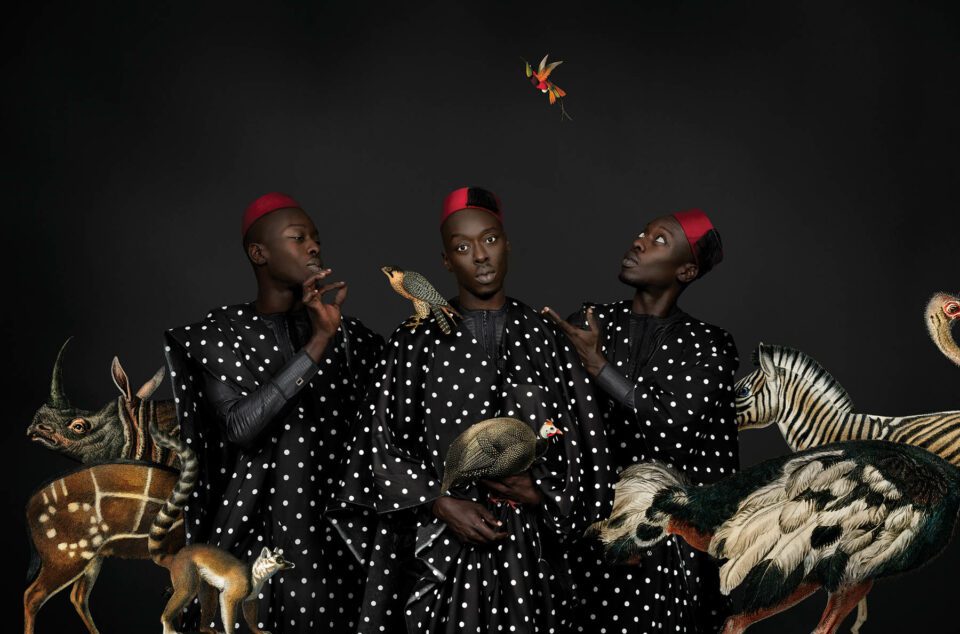Omar Victor Diop (b. 1980) is a Senegalese photographer who explores overlooked figures from the African diaspora. He connects past and present, both visually and conceptually, whilst exploring the complicated notions of identity, legacy and discovery. His previous series have offered journeys through time, celebrating individuals who have been instrumental to the emancipation of Black communities through elaborate self-portraits and acts of embodiment.
These portraits include the likes of Malick Ambar (1549- 1626), a child, who, due to poverty, was sold by his parents, before growing up to become Prime Minister of the Ahmadnagar Sultanate; Dom Nicolau (c. 1830-1860), thought to be the earliest African leader who wrote publicly to protest colonial rule; and Frederick Douglass (1818-1895), a social reform activist, writer and statesman who escaped from slavery and joined the abolitionist movement, becoming the first African American nominated to be Vice President of the USA. Here, Diop discusses his most recent project, Allegoria (2021), which follows on as a series from these vital portraits. In these images, the cultural politics of self-fashioning – the recasting of histories and the aesthetic styling of Black diasporic identities – couples with wider reflections on ecology.

A: When did your journey into photography begin?
OVD: It all began back in 2010. At that time, I still had my full-time job, working in corporate communications and finance for a multinational company that would have me traverse the African continent frequently. I didn’t hate the job, and the career was promising, but I was unfulfilled by it. I was a frustrated creative. I would spend most of my week- ends roaming around the city, shooting landscapes or ex- perimenting with natural light portraits in my backyard with an old friend posing for me. That’s how I ended up with my first project, Le Futur du Beau (2014), a series of imaginary editorial pictures for a fashion magazine, set in a future world where repurposed materials would be more valued than new clothes. That series opened doors to the African Biennale of Photography, Bamako, which was the beginning of my career.
A: In 2014, you began a series of costumed self-portraits, titled Diaspora, in which you inhabited the role of historical figures from central Europe from the 15th to 19th centuries, particularly the Baroque period, from around 1600 to 1750. Why did this time-period interest you?
OVD: This period is fascinating; first, these are the times of transatlantic slave trade and colonialism, provoking profound social, political and demographic changes in the western world, but, most importantly, in Africa. This era simultaneously witnessed a creative explosion in the field of portraiture through painting, sculpture and engravings. My attention was drawn to portraits of Africans depicted in postures of grandeur and dignity, by renowned artists like Diego Velázquez or Anne-Louis Girodet de Roussy-Trioson, which would normally be commissioned by popes, kings and rich merchants. Those discoveries made me want to know more about who these sumptuous African sitters were, and that’s how the historical research began. I found a trove of fascinating personal stories: resilient, creative and influential human beings who thrived in all parts of the world, despite the horrific contexts in which they lived. I describe these men, those I pay homage to, as forgotten African heroes.

A: Diaspora was the first time that you acted as both narrator and character, using your body as an object to pose as other individuals. What made you turn to the self as a conduit? How did this feeling of estrangement, embodiment, or indeed personal detachment, speak to you?
OVD: It didn’t! There hasn’t been a single moment in the research, production or presentation of the work where it was about me. Frankly, I don’t see myself when I look at the pictures. My body becomes a vehicle for these ancestors, and in the process of creating the compositions, I allow them to participate in a never-ending conversation about Africa, and her sons and daughters disseminated around the world. That being said, it is true that “investing” my body in the project made it feel more personal, a kind of ritual which I honoured.
A: You’ve represented many characters, from Omar Ibn Saïd, a Fula Islamic scholar who was enslaved and transported to the USA in 1807, to Albert Badin, foster son and servant to Louisa Ulrika, queen of Sweden. Could you elaborate on the figures you’ve performed as, who they were, and your selection process for these figures?
OVD: Jean-Baptiste Belley (1746-1805) is most definitely my favourite. Born in Senegal, he was enslaved in Saint- Domingue in the French West-Indies. He then became the first Black member of the French parliament right after the French Revolution. He was a founding father of modern France, but is still completely under-celebrated. I had never heard of him, and very few French or Senegalese citizens have either. These are the types of stories in this project – told for the sake of justice, and to unearth parts of history that we all share, and that we must all acknowledge with respect.

A: Isaac Julien (b. 1960) also works with modes of recreation. The film Lessons of the Hour (2019) meditates on the life and times of Frederick Douglass, a figure you’ve previously celebrated. Julien states that: “The most truthful representation is a combination of the subjective, political, emotional and cultural realms in mutual connection, and not some utopian idea of objectivity.” How do you see your work in relation to subjectivity?
OVD: I don’t see my work as being objective, though it does refer to historical evidence and facts. I create because I am touched and moved. These images are the result of a kind of ceremony that I practise, during which I invoke and channel ancestors that I could have been, if only I was born a few centuries ago. I think my own subjectivity and concurrent emotions are valuable ingredients in the creative process.
A: You’ve said that the “early relationships between African societies and western powers were characterised by deprivations of fundamental freedoms”, and that this altered the African diaspora forever. The 2016 series, Liberty, explores this, depicting events that have been pivotal in the fight for emancipation, from the Freeman Field Mutiny (1945) to the Soweto Uprising (1976). How did this series continue the conversation from your previous works, moving away from the personal to the collective?
OVD: When you look at the history of Black societies across the world, you cannot ignore the fact that collective action has been the ubiquitous mechanism of affirmation, and of survival. History is, therefore, a fantastic angle through which you can tell a story that, is, after all, universal: we all need our dignity to be intact; that’s a great part of being human. Black people have had to go to great lengths just to preserve their sense of dignity, and, unfortunately, we still have to.

A: Your latest series, Allegoria, puts us in the present-day, in the Anthropocene, in which both social and environmental injustices are pulled into focus. The collection calls upon the conventions of West African studio photography, religious iconographies and Japanese ukiyo-e woodblocking, as well as contemporary fashion. How do these diverse visual references work together, pointing towards the evocation of a more viable, “liveable” future, in which we work together as a global community?
OVF: I use these aesthetics like they are languages. I some- times joke that with every project it feels like I’m manifesting a new kind of creole – one that is visual, a mixture of cues from many civilisations and cultures. I am blessed to be an artist in an age when knowledge and references travel freely from, and to, all parts of the world. In the digital age, we are exposed to all cultures, with the ability to access them at all times, and I vow to be a creative sponge. The aim, also, is to visually impact a wider audience, a bit like a large-spectrum medicine that works by associating several molecules.
A: How did your relationship with allegory begin?
OVD: I’m West African; speaking in paraboles and expressing ideas through allegory is almost innate. I like the freedom that embedded meanings give to the artist, and also to the audience. You know what it’s about, as a viewer, but you have the liberty to go further and add layers of interpretation and draw more conclusions of your own. An allegory takes a life of its own; it is fed by the pairs of eyes that stare into it.
A: Beyond this, how does Allegoria (2021) connect to Lib- erty (2016) and Diaspora (2014)? Do you see your practice as part of a larger timeline, a trajectory in motion, or can any work be viewed on its own, independently?
OVD: These projects are personal diaries. I see myself as part of something greater: our collective human experience. Through these self-portraits, I navigate time, lending my body to the essence of human beings who have become reduced to ideas. These ideas, are, nonetheless, worth sharing. I’m an actor; I fall in love with characters and concepts. Yes, the series, or even the works themselves, can be viewed independently. After all, each composition tells the story of someone’s personal journey or a moment from the lives of a group of individuals; these narratives are so rich that they could have inspired an entire collection on their own.

A: Although you work solo, how far is your practice ultimately a collaborative one – sitting somewhere between past, present and future; personal and universal?
OVD: It’s a conversation: a great banquet of emotions, ideas, projections and introspections. Everything that I do is in response to something else. I think that’s, ultimately, how you honour your craft; by joining the dialogue and adding your own perspective. I don’t believe that an artwork can be entirely unique, since it’s moulded by multiple inspirations.
Words: Kate Simpson
Omar Victor Diop is at Turku Art Museum until 22 May. turuntaidemuseo.fi/en | omarvictor.com
Image Credits:
1. Omar Victor Diop, Allegoria 3 (2021). Pigment inkjet print on Canson Infinity Arches 88 paper. 50 x 75.6 cm. Edition of 7 + 2 artist’s proofs 80 x 121 cm.Edition of 5 + 1 artist’s proof. © Omar Victor Diop. Courtesy MAGNIN-A Gallery, Paris.
2. Omar Victor Diop, Allegoria 13 (2021). Pigment inkjet print on Canson Infinity Arches 88 paper. 60 x 60 cm. Edition de 7 + 2 artist’s proofs. 100 x 100 cm. Edition de 5 + 1 artist’s proof © Omar Victor Diop Courtesy MAGNIN-A Gallery, Paris.
3. Omar Victor Diop, Allegoria 8 (2021). Pigment inkjet print on Canson Infinity Arches 88 paper. 60 x 60 cm. Edition de 7 + 2 artist’s proofs. 100 x 100 cm. Edition de 5 + 1 artist’s proof © Omar Victor Diop Courtesy MAGNIN-A Gallery, Paris.
4. Omar Victor Diop, Allegoria 3 (2021). Pigment inkjet print on Canson Infinity Arches 88 paper. 50 x 75.6 cm. Edition of 7 + 2 artist’s proofs 80 x 121 cm.Edition of 5 + 1 artist’s proof. © Omar Victor Diop. Courtesy MAGNIN-A Gallery, Paris.
5. Omar Victor Diop, Allegoria 4 (2021). Pigment inkjet print on Canson Infinity Arches 88 paper. 50 x 75.6 cm. Edition of 7 + 2 artist’s proofs 80 x 121 cm.Edition of 5 + 1 artist’s proof. © Omar Victor Diop. Courtesy MAGNIN-A Gallery, Paris.
6. Omar Victor Diop,Allegoria 9 (2021). Pigment inkjet print on Canson Infinity Arches 88 paper. 75.6 x 50 cm. Edition of 7 + 2 artist’s proofs. 121 x 80 cm Edition of 5 + 1 artist’s proof. © Omar Victor Diop. Courtesy MAGNIN-A Gallery, Paris





